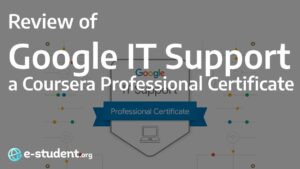Learning online is a relatively new concept, with the term “e-learning” being coined publicly for the first time as late as 1999. The first traditional university, on the other hand, was created as early as 859 in Morocco.
With such a massive head start, some educators automatically consider traditional classroom-based learning to be far more reliable. Yet, during the digital revolution, e-learning has started to emerge as a viable alternative to physical classrooms.
Online learning enables students to set their own learning pace, choose their own career trajectory, and absorb learning materials from the world’s top universities.

When learning online, students can choose where, how, and what they study more so than ever before.
Yet, digital learning is also plagued by problems such as social isolation, a lack of feedback and communicational skill development, and complicated cheating prevention.
Classroom learning, on the other hand, has traditionally taken place in a physical classroom setting — with the student-teacher interactions happening face-to-face. When questions arise, students have instant access to the teacher’s expertise and knowledge. And, there tends to be a sense of community among students.
Students in a traditional classroom learn in a social environment with their peers. Teachers get to know their students through informal communication, as well as during instruction. Dialogue and discourse are natural products of a traditional learning environment. In the right classroom atmosphere, the students can learn cooperation, all the while developing their social skills and alleviating social anxiety.
But, we all know that traditional learning also has its fair share of issues. University costs are rising eight times faster than wages, teacher shortages are becoming a major concern, and amidst the pandemic, we all saw that students sitting side-by-side in physical classrooms is not always as “safe and reliable” of a choice as we once thought.
This is why today, we’ll be analyzing which is better – online learning or traditional learning.
Here’s a quick guide to the questions covered in this article:
What are the differences in learning outcomes for E-Learning and classroom learning?
Learning outcomes are what students can expect to gain from completing a course, as decided by the instructors during the course design process.
Most traditional face-to-face learning programs have standardized objectives. For example, elementary learning objectives focus on “teaching to the test.” In other words, ensuring students understand the subjects that will be featured in standardized tests.
Online learning programs generally have similar learning outcomes.
When online learning is structured as face-to-face learning in a digital format, the outcomes are the same.
However, these online programs also feature additional niche outcomes — like helping students complete the course to experience career advancement.
With that, it’s challenging to compare face-to-face vs online learning without comparing learning objectives. We’ll focus on three main learning outcomes:
- Delivering knowledge to students in a way that helps them master the material
- Structuring the learning environment so that it supports learners’ goals
- Gaining an objective benefit from the courses
When focusing on most learning outcomes, online learning is just as good — if not better — than face-to-face learning.
How does traditional classroom-based learning deliver knowledge?
Traditionally, most in-person learning is conducted through a teacher-centered model. An instructor will lecture, assign work to facilitate information retention, and issue examinations to understand how students have learned the course material.

As more research is dedicated to different learning styles and teaching methods, face-to-face courses are slowly moving towards more student-centered learning environments. For example, some classrooms are experimenting with the “flipped” classroom model.
This model allows learners to work on their individual or group projects in class, assisted by the instructor, and watch pre-recorded lectures as “homework”. This decreases frustration with homework — as help is readily available — and everyone learns at the same pace.
Owing to the systems already cemented in place, this migration moves at a snail’s pace. A lot of work is required to change the existing delivery methods — especially when public funds are involved.
While educators are aware that the teacher-centered model isn’t the most effective, they’re constrained by the pre-existing status quo.
What about online courses?
The nature of online learning is one of adaptation and transformation. Online courses harness the advancement of technology to deliver knowledge differently. There is more interactivity and engagement when teaching students online.
The focus of online courses is to facilitate learning — vs delivering knowledge and leaving it to students to master the material. With various platforms, they can access multiple tools to increase their retention rates and master the material.
Studies are now showing that online modalities can more effectively teach because they shift the model of instruction delivery. While there are still “lecture” style pieces to online learning, they are supplemented by other learning strategies.
Online learning does a better job of delivering knowledge than face-to-face learning.
How is face-to-face learning structured for learners?
Education has traditionally been a formal institution. Courses are laid out for the students, attendance is compulsory, and lessons are designed based on overarching standards.
Face-to-face learning has a rigid structure. Because of the constraints of the traditional classroom environment, learners are afforded minimal flexibility.
Classes and exams take place at predetermined dates and times. Because learning requires your physical presence, students and instructors must coordinate attendance at the same time. There is no way to offer adaptability for any other commitments students might have.
The structure consists of lectures, homework, strict grading criteria, and examinations. While individual instructors might inject some creativity into the system, the formality of face-to-face learning leaves little room for flexibility.
Online learning offers more options for students
As learning goes digital, the adaptability of educators drastically increases. Since course meetings are virtual, there is no need for attendance at a physical location. And with the ability to pre-record lectures, there are also no time constraints to contend with.
Programs for learning online facilitate communication and interactivity. Students can access help when they need it, instead of being limited to in-person class times with teachers.
Online learning also serves a broader set of learning styles.
- Verbal learners, through e-learning, can make use of reading materials that help them increase retention rates.
- Spatial learners can use augmented and virtual reality technology to see topics come to life.
- Solitary learners are isolated from socializing distractions in a classroom setting and instead can focus on learning.
Online learning does require increased self-discipline, however. The lack of a rigid structure means some students who flourish within a structured format might not do well in online learning.

The student pictured above might be getting valuable feedback from the teacher. Yet, what we cannot see is what’s going on in the background, and whether anyone in the back of the classroom is paying any attention. E-learning solves that by delivering learning materials in an adaptive, personalized manner.
But most students are not served well under the traditional learning model.
Online learning provides greater accessibility and learning opportunities for students.
And thus, online learning wins again.
Online learning offers clearly defined benefits
Learning online is relatively new, but learner outcomes can be clearly defined by harnessing recent technology advancements.
There are objective benefits offered by many online programs. Some have career benefits and training, ensuring that students possess in-demand skills to bring to their careers.
Employers are beginning to develop online learning programs to ensure these graduates are ready for hard-to-fill jobs. For example, Udacity has created nano-degree programs in conjunction with AT&T to help narrow the skill gap.
Online learning can even facilitate ongoing employee training. When employees need to upskill or train for new positions, they can use online learning to develop their own specific curriculum.
Companies can facilitate learning for a fraction of the cost with online learning. Some organizations reduced their training costs by up to 60% by using virtual training programs.
Face-to-face and online learning both have concrete benefits. It’s hard to say which one is better, but online learning is undoubtedly just as good.
Online learning vs classroom learning: which is superior?
The answer to the question of whether online learning is as good as classroom-based learning largely depends on the learning goals of the student. In some cases, particularly in underdeveloped regions with poor digital skills, traditional learning can be more effective than digital learning. However, in developed parts of the globe, e-learning has proven itself to be just as effective as classroom learning.
Before deciding on one or the other, you should also ask yourself what’s your goal for enrolling in a learning program in the first place.
- Are you looking to advance your career?
- Do you wish to become a subject matter expert?
- Are you trying to get a degree?
You should choose an educational solution that matches your personal needs and goals. If your main goal is to advance your career or become a skillful expert, you will likely be better off studying online, as there are a vast number of valuable skills that can be learned online with ease. Online courses are excellent in terms of their cost-effectiveness, and through them, you can have access to the world’s best educational institutions at a fraction of the cost of a traditional Ivy League degree.
Traditional degrees are starting to matter less and less, while the cost of getting one is increasing year-by-year. Therefore, for career advancement purposes, we consider online learning to be far superior to traditional learning. That is – unless you live in a country where degrees are still considered a crucial advantage in the job market.
However, online learning still has a long way to go before it’s “the perfect solution” for everyone. Problems such as social isolation, strong self-motivation requirements, and hardware accessibility still plague the e-learning industry. And, because of that, e-learning is not yet a one-stop shop for everyone.



